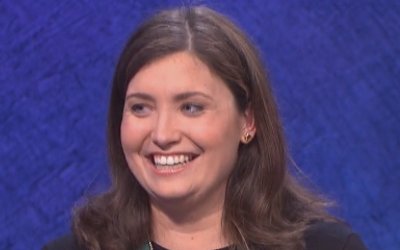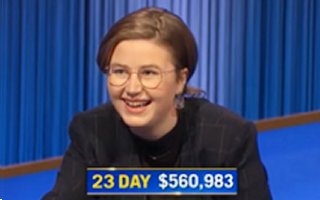Final Jeopardy: Iconic Brands (11-13-23)
Today’s Final Jeopardy question (11/13/2023) in the category “Iconic Brands” was:
In 1916 it began packaging its flagship product in a variety of glass called Georgia Green.
The Champions Wild Card quarter-finals continue today with these three champs: Emily Fiasco, a middle school band director from Saint Louis, MO; Stuart Crane, a product line manager from Kalispell, MT; and Fred Nelson, a university professor from Fresno, CA.
Round 1 Categories: The Auto Man Empire – Songs in Musicals – Old Names for Medical Conditions – Describing the Artwork – Dogs & Cats Living Together – Letter & Word
Stuart found the Jeopardy! round Daily Double in “Describing the Artwork ” under the $800 clue with 9 clues left after it. At $3,000, Stuart was tied for the lead with Fred. They had $1,000 more than Emily. Stuart made it a true Daily Double and he was RIGHT.
We’re not sure if you’d call that teal or azure the young man with a feathered cap is wearing in this 1770 work show
Stuart finished in the lead with $6,200. Fred was in second place with $6,000. Emily was last with $3,800. All clues were shown.
Round 2 Categories: The Ottoman Empire – Whose Line Is It Anyway? – City Museums – Say Cheese! – Life Science – From the Italian
Fred found the first Daily Double in “Whose Line is it Anyway?” under the $1,600 clue on the 16th pick of the round. He was in the lead with $13,200 now, $4,600 more than Stuart in second place. Fred bet $5,000 and he was RIGHT.
1960: “A boy’s best friend is his mother” show
Stuart got the last Daily Double in “Say Cheese!” under the $1,600 clue with 7 clues left after it. In second place with $10,200, he was $10,800 behind Fred’s lead. Stuart made it a true Daily Double and he was RIGHT.
Danbo, a cheese originally from this country is also known as King Christian IX when made with caraway seeds show
Fred finished in the lead with $23,000. Stuart was in second place with $20,400. Emily was last with $11,000. All clues were shown.
ALL of the contestants got Final Jeopardy! right.
WHAT IS COCA-COLA?
Coca-Cola was invented in July 1886 by a Georgia pharmacist who planned to market it as a medicinal beverage. 3 years later, Asa Griggs Candler bought the formula and incorporated the Coca-Cola Company in Atlanta in 1892. You can see the earlier bottles in the above video. The 1915 bottle was the result of a contest the Coca-Cola Company held for a new design. The Root Glass Company in Terra Haute, Indiana won the contest. Even though Coca-Cola contains no cocoa, Root Glass based their bottle design on the shape and ribbed exterior of a cocoa pod.
From Eaglesfield Percherons blog: “The term ‘Georgia Green’ was used to name these famous Coca-Cola contour bottles until 1956, tipping the hat to Coke’s home state. The green tint of the bottles was caused by impurities of the glass with iron oxide….”
Emily bet $4,347 and finished with $15,347.
Stuart bet it all and doubled his score to $40,800.
Fred bet $$17,801 and won the game with $40,801. Fred Nelson advances to the semi-finals.

2 triple stumpers from the last round:
THE OTTOMAN EMPIRE ($800) In 1571 the Holy League defeated Ottoman naval forces in the Gulf of Patras off the coast of Lepanto in this current nation
FROM THE ITALIAN ($800) Tossed at New Year’s, it has a name meaning “sweetmeats”, the little candies tossed during carnival
2 years ago: ALL of the players got this FJ in “Names in African-American History”
He was Virginia’s 1st African-American congressman, whose grandnephew, a famous poet, used his last name as a first name show
IF YOU HAVE SUGGESTIONS FOR CHANGES TO THE SHOW OR COMPLAINTS, PLEASE SEND YOUR FEEDBACK DIRECTLY TO JEOPARDY!
We may earn a small commission from qualifying purchases made from Amazon.com links at no cost to our visitors. Learn more: Affiliate Disclosure.









Really good game, strong players, not a lot of stumpers. Only one I got was the “sweetmeats/New Year’s” clue. I thought FJ was a cinch–if you knew Coke is HQ’d and originated in Atlanta, it was a gimme.
Stuart probably should have wagered $2601. He had to hope Fred missed (which he didn’t), and wagered $17801 (which he did). And such a wager on Stuart’s part would have locked out Emily if she bet it all and both got it right. And he’d easily have had enough to win if both he and Fred missed, in part thanks to Emily’s weird wager.
I can recall Coca Cola being marketed and sold in those greenish bottles, but that was a long time ago. Anyways, I didn’t come up with the correct response for FJ. While we’re on the same subject, I’ve been making homemade pop for some years now since the major bottlers still refuse to add cane sugar to their carbonated beverages. As many were aware, the major bottlers had been substituting fructose (corn syrup) for cane sugar since the mid 1980s, and the taste had subsequently suffered as a result.
I drink only diet soda, but many brands now feature “real sugar” as well as “zero sugar” (instead of diet). Corn syrup has been removed from many products in recent times.
Have you ever wondered why Diet Coke tastes like it does? It’s the “Coke II” formulation from the 80s. Why did Coke take it’s singular flagship product and change it? Roberto Goizueta, CEO at the time, said it was just bad thinking on their part. Uh, no. Coke was taking cane sugar out of the formula. They introduced this very different flavor, knowing the consumers would clamor for the original. So, “remarkably”, they came to their senses, and reintroduced the “original”, which really wasn’t, as it now had the high fructose corn syrup in it. After the off taste of Coke II, people didn’t notice the slight difference.
Ironically, they couldn’t get the the flavor right for the sugar free. When Coke Zero came out, in 2005, they finally found something that worked. Also, Coke Zero was marketed very differently from Diet Coke – different jingle, and the black containers. That’s because 20 year old men didn’t want a 35 year old woman’s soda.
Mexican Coke retains the cane sugar.